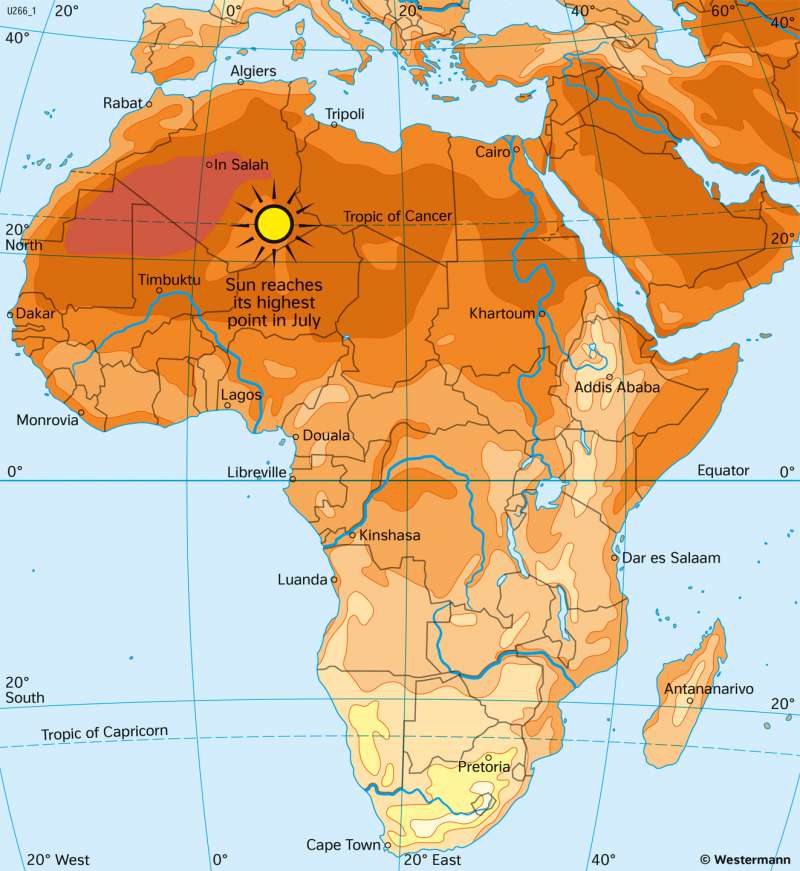Africa - Temperatures in July
Climate and Nile catchment
978-3-14-100890-6 | Page 146 | Ill. 2

Overview
The African continent extends over two climate zones: the tropics near the equator and the subtropics beyond the tropics. North of the equator, January is winter, just like in Europe. South of the equator, on the other hand, it is summer in January. Due to the high position of the Sun throughout the year, high temperatures are reached even in the winter in northern Africa. Even in the mountains, the monthly average temperatures in winter do not fall below zero degrees. In the lowlands, temperatures even range from about 10 °C beyond the Tropic of Cancer to over 25 °C at the equator. In summertime in South Africa, temperatures do not fall below 10 °C, even at higher altitudes.
Reasons for the distribution of temperature
The temperature in Africa is mainly determined by solar radiation, cloud cover and evaporation. Evaporation in turn depends on the amount of precipitation and solar radiation. In the equatorial latitudes, the Sun is very high all year round. In the midday hours, the strongest energy input from the Sun on earth occurs at the equator. Within the so-called Intertropical Convergence Zone (ITCZ), which runs along the equator, there is constant dense cloud cover and heavy rainfall. Part of the solar radiation is reflected by the cloud cover and thus does not warm the Earth's surface. The high precipitation at the equator also leads to strong evaporation. A lot of energy is needed for the evaporation of water. Therefore, another part of the Sun's radiant energy is converted into latent (hidden) heat and not into heat that we can feel. Due to cloud cover and high evaporation, the highest temperatures in Africa do not occur near the equator, but in the area of the tropics. In the horse latitudes (subtropical high-pressure belt), the air sinks and warms up in the process. Therefore, clouds dissolve, for example, over the Sahara. These regions are extremely dry - it almost never rains, and the Sun shines unhindered on the Earth's surface, meaning that it sometimes gets very hot. In the interior of the Sahara, temperatures reach over 50 °C during the day. At night and in winter, however, the radiation of heat into space is very high because there are no clouds hanging in the atmosphere like a protective blanket. Therefore, it cools down very much, especially at night, but also in winter.
Daily and annual temperature fluctuations
The relatively uniform supply of radiation throughout the year leads to the formation of a typical tropical diurnal climate near the equator. The seasonal temperature differences are much smaller than those between day and night. For this reason, temperatures in tropical Africa fluctuate by no more than one temperature level between January and July. With increasing distance from the equator, the seasonal temperature differences increase. This is particularly evident beyond the tropics. The monthly average temperatures there can be as high as 20 °C.
Daily and annual temperature fluctuations
The relatively uniform supply of radiation throughout the year leads to the formation of a typical tropical diurnal climate near the equator. The seasonal temperature differences are much smaller than those between day and night. For this reason, temperatures in tropical Africa fluctuate by no more than one temperature level between January and July. With increasing distance from the equator, the seasonal temperature differences increase. This is particularly evident beyond the tropics. The monthly average temperatures there can be as high as 20 °C.




